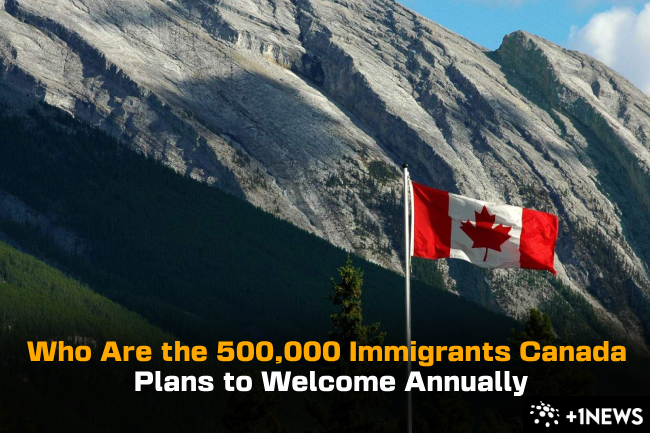Canada plans to welcome about 1.5 million new permanent residents in the next three years. This was announced by Marc Miller, the Immigration Minister.
Jump to:
Steady Immigration Levels
Canada’s commitment to immigration remains strong, with no intention of reducing immigration levels.
Canada will keep allowing 500,000 new people to come each year starting in 2026. This plan was shared in Parliament by Miller. By looking more closely at the details, we can understand better who these new people coming to Canada will be.
Categories of New Permanent Residents
The Immigration Levels Plan classifies individuals into four categories;
- Economic Migrants
- Family Reunification
- Refugees and Protected Persons
- Humanitarian, Compassionate and Others
Now let’s dive into each category’s breakdown and the expected numbers for the years.
Economic Migrants
The majority of newcomers are expected to be migrants. By 2024 about 281,135 economic migrants are projected to arrive, with an increase to 301,250 per year in both 2025 and 2026.
Family Reunification
Canada places importance on family reunification well. The figures for this category are set to rise from 114,000 in 2024 to 118,000 in both 2025 and 2026. This includes spouses, partners, children, parents and grandparents of citizens and permanent residents.
Changes in Categories
While there is a trend in the number of economic immigrants and family members being admitted into Canada there will be changes in other categories;
- Refugees and protected persons: The number is expected to decrease from 76,115 in 2024 to approximately 72,750 individuals annually in both 2025 and 2026.
- Humanitarian and compassionate grounds: This category will also see a decline from around 13,750 individuals, in 2024 to only eight thousand each year in both 2025 and
Economic Categories in Detail
There are several sub-categories under the category of economics. Here’s a closer look:
Provincial Nominee Program (PNP)
PNP is expected to bring in 110,000 newcomers in 2024.
The program will give 120,000 people an opportunity to settle in Canada by 2025 and 2026 respectively.
Atlantic Immigration Program
The Atlantic Immigration Program is designed to promote settlement in Canada’s Atlantic provinces.
In 2024, 6,500 people will be welcome; in 2025 and 2026, 8,500 will be welcomed every year.
Federal High Skilled Program
This includes the Federal Skilled Worker Program, Federal Skilled Trades Program, and workers with prior Canadian work experience.
In 2024, the federal high skilled program will welcome 110,770 new permanent residents. There is a similar pattern for 2025 and 2026 where there will be 117,500 new permanent residents per year
Federal Business Visas
This year, Canada will issue 5,000 of these Federal Business visas while aiming to increase this number to 6,000 per annum from the following year.
Special Immigration Pilots
The Canadian government has also started a number of pilots responding to labor needs, especially in the spheres of caregivers, healthcare workers, agri-food workers, and other fields.
These include the Rural and Northern Immigration Pilot and the Economic Mobility Pathways Project. This category will issue 10,875 visas in 2024.
In the current year, this number will be 9750 and it will increase to 14,750 in 2025 and then drop to 13,750 in 2026.
Promoting Francophone Immigration
Canada will pursue immigration of francophones outside Quebec. Besides the aggregate annual goal of 485,000, Ottawa aims at admitting 26,100 French-speaking permanent residents from outside Quebec in 2024.
For that year the target will move from 25,000 to 31,500 and subsequently move from 31,500 to 36,000 in 2026.
Canada To Welcome Francophone Immigrants Under Immigration Plans 2024-2026
Aligning Immigration with Labor Market Needs
Canada is really trying to match its immigration plans with what its job market needs. They’re looking to bring in people from all over the world who have the skills that Canada is short on.
They’re even thinking of having a special person in charge, called a Chief International Talent Officer, to make sure everything goes smoothly.
But, it’s not all easy. Claire Fan, who knows a lot about economics at the Royal Bank of Canada, says there’s a big problem. Many people who come to Canada, especially those who are really good in areas like medicine, find it tough to work in their field. There are just too many hurdles for them.
Also, Canada has been depending a lot on temporary workers from other countries. Now, they’re trying to make it easier for these workers, including students from other countries, to stay in Canada for good.
Sarom Rho, who looks after student issues for a group called Migrant Students United, says we shouldn’t forget about international students.
They’re not just studying; they’re also working hard, often in tough jobs like delivering food in bad weather or working night shifts at places like Amazon. On top of that, they have to pay really high fees for their education.
According to Global News, Sarom Rho said,
“It’s international students who are on their bikes through the sleet and the rain, making food deliveries, who are working overnight, are handling packages at Amazon warehouses, all the while having to pay for extremely high tuition fees.”
Sarom Rho
He adds,
“International students are not just students, they are workers and they are migrants. And they face the same exploitations and denial of rights as other migrants do.”
Sarom Rho














